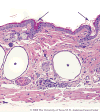The hairless mouse in skin research
- PMID: 18938063
- PMCID: PMC2646590
- DOI: 10.1016/j.jdermsci.2008.08.012
The hairless mouse in skin research
Abstract
The hairless (Hr) gene encodes a transcriptional co-repressor highly expressed in the mammalian skin. In the mouse, several null and hypomorphic Hr alleles have been identified resulting in hairlessness in homozygous animals, characterized by alopecia developing after a single cycle of relatively normal hair growth. Mutations in the human ortholog have also been associated with congenital alopecia. Although a variety of hairless strains have been developed, outbred SKH1 mice are the most widely used in dermatologic research. These unpigmented and immunocompetent mice allow for ready manipulation of the skin, application of topical agents, and exposure to UVR, as well as easy visualization of the cutaneous response. Wound healing, acute photobiologic responses, and skin carcinogenesis have been extensively studied in SKH1 mice and are well characterized. In addition, tumors induced in these mice resemble, both at the morphologic and molecular levels, UVR-induced skin malignancies in man. Two limitations of the SKH1 mouse in dermatologic research are the relatively uncharacterized genetic background and its outbred status, which precludes inter-individual transplantation studies.
Conflict of interest statement
Figures





References
-
- Panteleyev AA, van der Veen C, Rosenbach T, et al. Towards defining the pathogenesis of the hairless phenotype. J Invest Dermatol. 1998;110:902–7. - PubMed
-
- Djabali K, Aita VM, Christiano AM. Hairless is translocated to the nucleus via a novel bipartite nuclear localization signal and is associated with the nuclear matrix. J Cell Sci. 2001;114:367–76. - PubMed
Publication types
MeSH terms
Grants and funding
LinkOut - more resources
Full Text Sources
Other Literature Sources
Medical

